ISSN ONLINE(2278-8875) PRINT (2320-3765)
ISSN ONLINE(2278-8875) PRINT (2320-3765)
Peeyush Agarwal, Arvind S.M, Sangya Thakur
|
| Related article at Pubmed, Scholar Google |
Visit for more related articles at International Journal of Advanced Research in Electrical, Electronics and Instrumentation Engineering
Numerous technologies have been deployed to assist and manage transportation. But recent concerted efforts in academia and industry point to a paradigm shift in intelligent transportation systems. Vehicles will carry computing and communication platforms, and will have enhanced sensing capabilities. They will enable new versatile systems that enhance transportation safety and efficiency and will provide infotainment. This paper surveys the state-of-the-art approaches, solutions, and technologies across a broad range of projects for vehicular communication systems.
Keywords |
| communication network,V2V , AD-HOC, VANET , GPS |
INTRODUCTION |
| A telecommunications network is a collection of terminal nodes, links and any intermediate nodes which are connected so as to enable telecommunication between the terminals. |
| The transmission links connect the nodes together. The nodes use circuit switching, message switching or packet switching to pass the signal through the correct links and nodes to reach the correct destination terminal. |
| This paper aims at understanding the application of Communication Networks in the automotive field and how beneficial and convenient it is in today’s world. A Communication System is used in automobiles for GPS Navigation, Voice Assist, Control Cruise, Emergency services post an accident etc. |
| Vehicular Communication Systems are an emerging type of networks in which vehicles and roadside units are the communicating nodes; providing each other with Cinformation. As a cooperative approach, vehicular communication systems can be more effective in avoiding accidents and traffic congestions than if each vehicle tries to solve these problems individually. |
| Generally vehicular networks are considered to contain two types of nodes; vehicles and roadside stations. Both are Dedicated Short Range Communications (DSRC) devices. DSRC works in 5.9 GHz band with bandwidth of 75 MHz and approximate range of 1000m. |
II. VEHICULAR AD-HOC NETWORKS(VANET) |
| • A Vehicular Ad-Hoc Network, or VANET is a technology that uses moving vehicles as nodes in a network to create a mobile network. VANET turns every participating vehicle into a wireless router or node, allowing vehicles approximately 100 to 300 meters of each other to connect and, in turn, create a network with a wide range. |
| • As vehicles fall out of the signal range and drop out of the network, other vehicles can join in, connecting vehicles to one another so that a mobile Internet is created. |
| • VANET is a subgroup of MANET where the nodes refer to vehicles. Since the movement of Vehicles are restricted by roads, traffic regulations we can deploy fixed infrastructure at critical locations. |
| • The primary goal of VANET is to provide road safety measures where information about vehicle’s current speed, location coordinates are passed with or without the deployment of Infrastructure. |
| • Apart from safety measures, VANET also provides value added services like email, audio/video sharing etc,. |
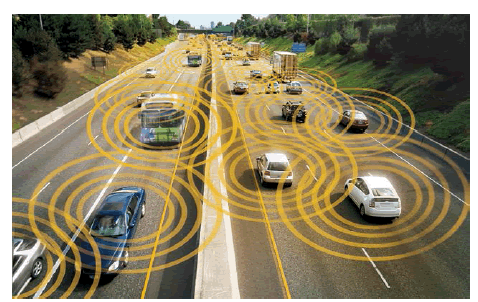 |
III. COMMUNICATION SYSTEMS |
| • Vehicle to Vehicle (V2V) |
| • Vehicle to Infrastructure (V2I) |
| • Vehicle to Roadside (V2R) |
Hybrid Models |
| • Vehicle to Vehicle (V2V) & Vehicle to Infrastructure (V2I) |
| • Vehicle to Vehicle (V2V) & Vehicle to Roadside (V2R) |
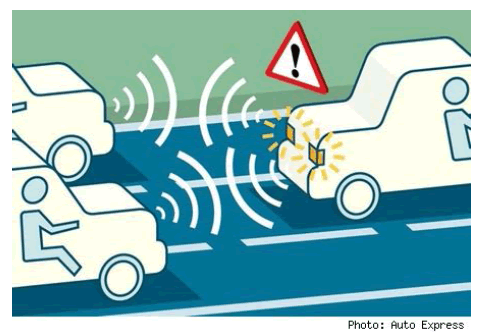 |
IV. VEHICULAR COMMUNICATION SYSTEM NETWORK |
| Vehicle-to-Vehicle Communications for Safety is the dynamic wireless exchange of data between nearby vehicles that offers the opportunity for significant safety improvements. By exchanging anonymous, vehicle-based data regarding position, speed, and location (at a minimum), V2V communications enables a vehicle to: sense threats and hazards with a 360 degree awareness of the position of other vehicles and the threat or hazard they present; calculate risk; issue driver advisories or warnings; or take pre-emptive actions to avoid and mitigate crashes. At the heart of V2V communications is a basic application known as the Here I Am data message. This message can be derived using non-vehicle-based technologies such as GPS to identify location and speed of a vehicle, or vehiclebased sensor data wherein the location and speed data is derived from the vehicle’s computer and is combined with other data such as latitude, longitude, or angle to produce a richer, more detailed situational awareness of the position of other vehicles. Because the Here I Am data message can be derived from non-vehicle-based technologies that are ubiquitous within the marketplace, the ITS Program may leverage an opportunity to accelerate V2V capability and deployment in the near-term and produce safety benefits through reduced crashes sooner than through Original Equipment Manufacturer(OEM) embedded systems only. |
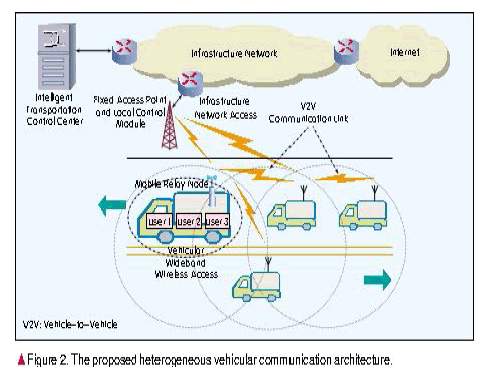 |
| The vision for V2V is that eventually, each vehicle on the roadway (inclusive of automobiles, trucks, buses, motor coaches, and motorcycles) will be able to communicate with other vehicles and that this rich set of data and communications will support a new generation of active safety applications and safety systems. V2V communications will enable active safety systems that can assist drivers in preventing 76 percent of the crashes on the roadway, thereby reducing fatalities and injuries that occur each year. |
| V2V Communications for Safety is a key component in the USDOT's Vehicle to Vehicle Communications program, and is complemented by research programs that support connectivity among vehicles and infrastructure (V2I) and among vehicles and consumer devices (V2D) to deliver safety and mobility benefits. |
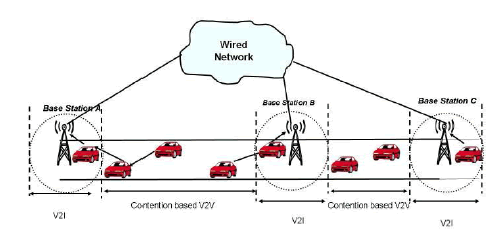 |
V. RESEARCH QUESTIONS |
| The following research questions will be answered by the Vehicular Communication Systemsfor Safety Program |
| ïÃâ÷ Are applications effective and are benefits validated? |
| ïÃâ÷ What infrastructure is needed? How much, where, when, and what type? |
| ïÃâ÷ What is the degree of market penetration needed and what is the required timing for effectiveness? |
| ïÃâ÷ What existing technologies can be leveraged to accelerate in-vehicle equipment? |
| ïÃâ÷ What are the special needs and applications for truck and transit vehicles? |
| ïÃâ÷ What is the business case for implementation? |
VI. RESEARCH APPROACH |
Overview |
| Since 2002, the USDOT has been conducting research with automotive manufacturers in order to assess the feasibility of developing effective crash avoidance systems that utilize vehicle-to-vehicle communications. |
| Engineering prototypes have been developed and demonstrated with applications that address the most critical crash scenarios which are: |
| ïÃâ÷ Emergency Brake Light Warning |
| ïÃâ÷ Forward Collision Warning |
| ïÃâ÷ Intersection Movement Assist |
| ïÃâ÷ Blind Spot and Lane Change Warning |
| ïÃâ÷ Do not pass Warning |
| ïÃâ÷ Control Loss Warning |
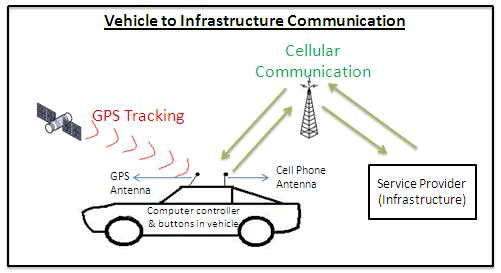 |
| The development of these applications was critical to understanding the functional and performance requirements for the underlying technologies such as positioning and communications. However, additional work needs to be done to address more complex crash scenarios for head-on collision avoidance, intersection collision avoidance, pedestrian crash warning and extending the capabilities to prevent motorcycle crashes. |
| It is important to note that these capabilities could be achieved by providing V2V communication capabilities that complement other vehicle-based safety technologies. |
| This research plan consists of eight tracks that have been identified to represent the major research activities that are required to attain accelerated deployment of V2V based safety systems. The work program for the V2V Communications for Safety will continue the work started in 2002 to assess the feasibility of developing effective crash avoidance systems that utilize vehicle-to-vehicle communications. This research program will result in V2V communications capabilities that complement vehicle-based safety technologies that are currently available or under development throughout the automotive industry. |
| The work program will deliver: |
| ïÃâ÷ Sponsor collaborative research |
| ïÃâ÷ Guidelines and standards in collaboration with stakeholders |
| ïÃâ÷ Voluntary standards and regulations |
| ïÃâ÷ Compliance and longer term safety impact |
| ïÃâ÷ Infrastructure and implementation governance mechanism |
| ïÃâ÷ Supporting data for regulatory decisions |
| ïÃâ÷ Inputs to industry standards for promoting interoperability |
| ïÃâ÷ Human Factors guidelines |
| ïÃâ÷ Governance |
| A measure of success for the V2V Communications for Safety Program is the ability to answer critical research questions. The V2V Roadmap has been designed to provide the research, information, and demonstrated capabilities to answer these research questions. |
Program Tracks |
| Track 1 – Crash Scenario Framework The key objective of this track is to connect pre-crash scenarios to crash avoidance safety applications providing information that will enable the identification of safety application function, performance, and initial effectiveness benchmarks. This will establish a framework by which the crash scenarios are defined and new crash avoidance capabilities identified and described; ultimately leading to the selection of prototype applications that will be developed under the V2V Communications Program. |
| Track 2 – Interoperability The key objective of the interoperability track is to resolve interoperability issues to ensure that safety applications work across all equipped vehicles and devices, regardless of make or model and original equipment or retrofit. Interoperability is critical to the effectiveness of V2V safety systems. |
| Track 3 – Benefits Assessment The key objective of the benefits assessment track is to estimate the safety benefits that may be realized by deployment of various V2V safety applications. In addition, a methodology for estimating safety benefits for these and future safety applications will be implemented. Performance measures, objective test procedures, and an adapted version of the Advanced Crash Avoidance Technologies (ACAT) Safety Impact Methodology will be used to determine the safety benefits. Once estimates of safety benefits are validated, the safety application will be considered for either new regulation or the New Car Assessment Program (NCAP) process. |
| Track 4 – Application Development The key objective of Track 4 is to develop the selected safety applications, identified as the result of Track 1 efforts, into safety application prototypes. Information from the various tracks will provide an initial basis for the design and development of the selected safety application prototypes. |
| Track 5– Driver Issues The key objective of this track is to develop a framework that can assess the impact of driver issues on the effectiveness of V2V based safety applications with a goal of developing a framework for implementing drivervehicle- interfaces (DVIs) in an environment where applications may be periodically updated. Understanding if drivers have accurate mental models is essential to achieving the desired safety impact. |
| Track 6 – Vehicle to Vehicle Communications Policy Issues The key objective of Track 6 is to identify the main V2V policy issues and accomplish coordination with policy issues of the broader connected vehicles program policies. Work activities will be addressed within the Vehicle-to- Vehicle Communications Policy Roadmap with coordination with the V2V program. |
| Track 7 – Commercial Vehicle Applications The key objective of this track is to ensure that unique aspects of commercial vehicles that are critical to the successful deployment of V2V are addressed. Once estimates of safety benefits are validated, the safety application will be considered for Commercial Vehicle Operations(CVO) regulation decision. |
| Track 8 – Transit Vehicle Applications The KEY objective of this track is to ensure that unique aspects of transit vehicles that are critical to the successful deployment of V2V are addressed. To that end, a comprehensive transit vehicle safety analysis must first be conducted that will support the identification of both V2V and V2I transit safety applications. Once the applications have been identified, a determination will be made regarding which applications to move to prototype development and evaluation. |
VII. CHALLENGES TO VEHICLE TO VEHICLE APPLICATION |
| Using V2V communication, when a vehicle on the road acts abnormally, e.g., deceleration exceeding a certain threshold, dramatic change of moving direction, major mechanical failure, etc., it becomes an abnormal vehicle (AV). An AV actively generates Emergency Warning Messages (EWMs), which include the geographical location, speed, acceleration and moving direction of the AV, to warn other surrounding vehicles. A receiver of the warning messages can then determine the relevancy to the emergency based on the relative motion between the AV and itself. |
VIII. UTILIZING VEHICULAR COMMUNICATION SYSTEM NETWORK |
| Real time information to vehicular users is proposing new challenging questions to which wireless systems designers are called to answer. Nowadays many vehicles are already equipped with devices able to connect to cellular networks, and to transmit and receive in real time traffic information through vehicle-to-infrastructure (V2I) communication. Focusing on the uplink transmission of real time measurements, this is leading to high costs in terms of network load and billing. In this work we discuss the opportunity to take advantage of vehicle-to-vehicle (V2V) in addition to V2I communications to reduce the amount of data to be transmitted from vehicles to a remote control center, and thus also to reduce the resulting costs for transmissions over the cellular networks. Having in mind to allow a first understanding of the achievable advantages, we propose a simple mathematical model through which we discuss how many vehicles are necessary to guarantee an useful V2V communication and which are the advantages in terms of network load and, consequently, costs reductions for the V2I network. |
IX. CONCLUSION |
| Thus we see how technology can help us in avoiding fatal accidents. The V2V technology is further being worked upon and soon we’ll have technologies like automatic breaking systems. Moreover the audio system will be integrated to the GPS system via Bluetooth so that the driver does not have to look at the GPS and get distract, instead there would be an announcement giving information of the colliding vehicle with respect to its position, speed, accurate time of collision and distance from another vehicle. In case of no reaction time in hand the ability of the vehicle to stop on its own with automatic breaking system. |
| Anyway, with the very superficial knowledge of ours we have compiled the presentation. Thank you! |
X. ACKNOWLEDGMENT |
| I, Peeyush Agarwal would like to thank the help and guidance of his teachers in College who provide him with the base for this paper. Also, would like to thank my parents for their love and blessings. |
| Arvind S.M would like to thank his friends and family for their support with the blessings from the Almighty. |
| Sangya Thakur would like to take this opportunity to thank her teachers and parents . |
References |
|